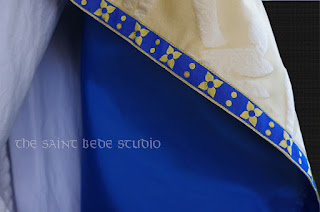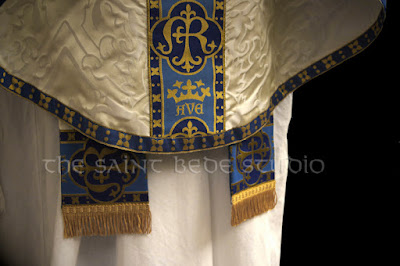Tuesday, 31 December 2024
As 2024 draws to a close
Saturday, 28 December 2024
In this Christmas Season
Enquiries : stbede62@gmail.com
Information on placing an order.
Thursday, 26 December 2024
On the Feast of Saint Stephen
Enquiries : stbede62@gmail.com
Information on placing an order.
Tuesday, 24 December 2024
On this Holy Day
Every valley shall be exalted, and every mountain and hill be made low; the crooked shall be made straight and the rough places, plain; and the Glory of the Lord shall be revealed and all flesh shall see it together, for the mouth of the Lord has spoken it.
Isaiah 40:4-5.
Michael Sternbeck
The Saint Bede Studio
December 2024
Saturday, 21 December 2024
In this season of Advent : 3
The Saint Bede Studio : vestments made by Catholics for Catholics.
Enquiries : stbede62@gmail.com
Information on placing an order.
Friday, 20 December 2024
A Rose by any other name, but Pink
Twice a year, the Church breaks the tone of its penitential seasons by the use of rose-coloured vestments. Rose-coloured vestments were never commonplace and they still are not. Nevertheless, you will find various pronouncements these days (usually on websites) about what the real or authentic shade of rose is which is to be used for vestments.
 |
Pope Paul VI greeting a priest
after Mass in Saint Peter's on Laetare Sunday 1978. Both are wearing rose
chasubles made from dupion silk.
Image: L'Osservatore Romano |
Tuesday, 17 December 2024
Rose Vestments in the Gothic Revival Style
The vestments of the Saint Bede Studio are beautiful in design, sound in construction and distinctive in appearance.
Sunday, 15 December 2024
Gaudete Sunday 2024
The vestments of the Saint Bede Studio are beautiful in design, sound in construction and distinctive in appearance.
Friday, 13 December 2024
In this Advent Season : 2
The Saint Bede Studio : vestments made by Catholics for Catholics.
Enquiries : stbede62@gmail.com
Information on placing an order.
Tuesday, 10 December 2024
In this Advent Season : 1
The Saint Bede Studio : vestments made by Catholics for Catholics.
Enquiries : stbede62@gmail.com
Information on placing an order.
Sunday, 8 December 2024
On the Immaculate Conception
We should describe this braid, for those who have not followed previous posts closely. It employs two shades of blue, one a sky blue, the other Royal Blue and upon these two colours, the ornamental design is figured in (non-metallic) gold.
Within a Royal blue quatrefoil (four-leafed flower) is a stylised monogram being the letters MR. This is the Latin abbreviation of Maria Regina (Mary the Queen). It was very typical in the Mediaeval period for such monograms to appear as decorative schemes in churches and upon vestments.
These quatrefoils alternate with another emblem, which is upon a light blue base. Here is a crown emphasising the Queenship of the Blessed Virgin. Below it, in heraldic lettering, is the greeting AVE. From this is derived the name of this braid and based on the beautiful Marian antiphon Ave Maris Stella (Hail, Star of the Sea).
Running along either side of this orphrey is a row of smaller quatrefoils in gold, upon the Royal Blue base.
Although not directly-based on the work of the Gothic designer AWN Pugin, this Ave Maris Stella braid incorporates Puginesque elements. No matter whether you shop for your vestments in Poland, India, England or America, you will not find another braid like Ave Maris Stella. It is just one of the Saint Bede Studio's unique braids, designed by the writer of this blog and made exclusively for the Studio's use.
Click on the image for an enlarged view.
The vestments of the Saint Bede Studio are beautiful in design, sound in construction and distinctive in appearance.
Saturday, 7 December 2024
Violet Gothic Revival Vestments
The vestments of the Saint Bede Studio are beautiful in design, sound in construction and distinctive in appearance.
Monday, 2 December 2024
Liturgical Colours of Advent (Re-visited)
Click on the image for an enlarged view.



















